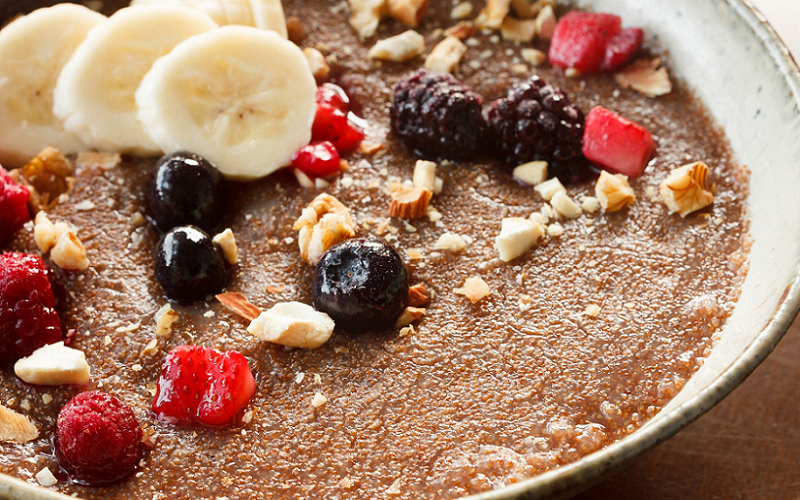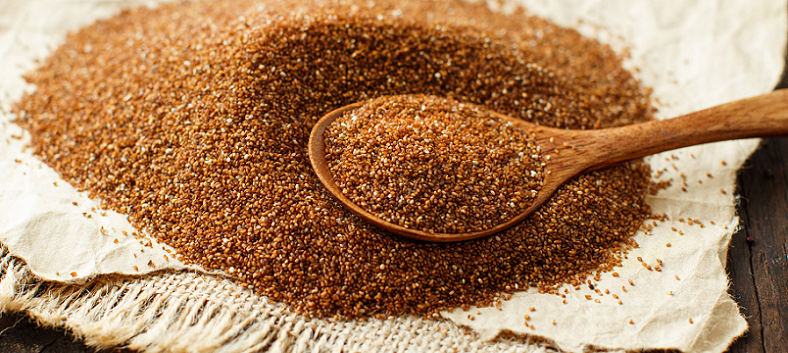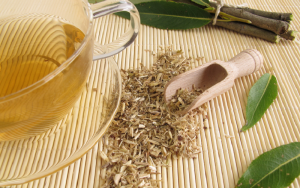
Teff, an ancient grain that dates back thousands of years, has been a staple food source in Ethiopia and Eritrea for centuries. Today, this tiny but nutritionally dense grain is gaining popularity worldwide for its impressive health benefits and versatile culinary applications. Here we explore the origins of teff, its unique nutritional composition, and its multitude of health advantages.
Contents
Introduction to Teff
Teff, an ancient grain that dates back thousands of years, has a history that can be traced back over 5,000 years to the ancient civilization of Abyssinia, now known as Ethiopia. This small grain, scientifically named Eragrostis tef, has been a fundamental part of Ethiopian and Eritrean diets since that time. Due to its ability to grow in diverse climates and its resistance to drought, teff has sustained populations in the Horn of Africa for centuries, playing a crucial role in their food security and culture [1].
Teff is indigenous to the Horn of Africa, primarily Ethiopia and Eritrea, where it continues to be a major crop. As one of the smallest grains in the world, each teff seed measures less than 1 millimeter in diameter. Despite its tiny size, teff is a resilient and hardy crop, capable of thriving in a variety of environments, from waterlogged areas to dry, arid climates.
In recent years, teff’s popularity has expanded beyond its traditional boundaries. It is now being cultivated in countries such as the United States, Australia, and Israel due to its nutritional benefits and increasing global demand. This ancient grain is poised to make a significant impact on the modern food industry as more people discover its remarkable nutritional profile and health advantages.

Nutritional Composition of Teff
One of the key reasons behind teff’s growing popularity is its exceptional nutritional composition. In this section, we will examine the macronutrients, vitamins, minerals, and fiber content of teff, as well as its gluten-free and low glycemic index properties. Understanding the nutrient profile of teff will help showcase why it is considered a valuable addition to a health-conscious diet.
Macronutrients
Macronutrients are the primary components of our diet, consisting of proteins, carbohydrates, and fats. Teff has a well-balanced macronutrient profile, making it a great source of energy and nutrition [2].
Protein Content and Quality
Teff is an excellent source of plant-based protein, containing all nine essential amino acids required by our bodies. A single cup of cooked teff provides about 10 grams of protein, making it an ideal option for vegetarians, vegans, and anyone seeking an alternative to animal-based protein sources.
Carbohydrate Profile
Teff is primarily composed of complex carbohydrates, which are beneficial for maintaining steady energy levels and promoting digestive health. Its relatively low glycemic index, ranging between 57-65, ensures that the carbohydrates are slowly absorbed into the bloodstream, helping to prevent spikes in blood sugar levels.
Healthy Fats
Although teff is low in fat, it contains a small amount of heart-healthy unsaturated fats, including omega-3 and omega-6 fatty acids. These essential fatty acids play a crucial role in supporting brain function, reducing inflammation, and maintaining healthy cholesterol levels.
Vitamins and Minerals
Teff is a powerhouse of essential vitamins and minerals, contributing to its status as a nutrient-dense grain.
Iron and Calcium
Teff is an excellent source of iron, providing about 30% of the daily recommended value in just one cup of cooked grain. Iron is vital for oxygen transport in the blood and proper immune function. Additionally, teff is high in calcium, which is essential for strong bones and teeth, as well as nerve function and muscle health.
B-Vitamins and Vitamin C
This ancient grain is also rich in B-vitamins, including thiamin, riboflavin, niacin, and vitamin B6, which play important roles in energy production and maintaining a healthy nervous system. Surprisingly, teff also contains a small amount of vitamin C, a powerful antioxidant that helps protect our cells from damage and supports the immune system.
Other Essential Minerals
Teff is a good source of other essential minerals such as magnesium, phosphorus, potassium, and zinc. These minerals are crucial for various bodily functions, including nerve and muscle function, bone health, and maintaining a healthy immune system.
Fiber Content and Health Benefits
Teff is high in fiber, with a single cup of cooked teff providing approximately 7 grams of dietary fiber. This can help support digestive health, promote satiety, and aid in weight management. The fiber content in teff also helps regulate blood sugar levels and supports heart health by lowering cholesterol levels.
Gluten-Free and Low Glycemic Index
For those with celiac disease or gluten sensitivity, teff is a fantastic alternative to traditional grains, as it is naturally gluten-free. Its low glycemic index also makes it a suitable option for individuals with diabetes or those looking to maintain stable blood sugar levels. Overall, teff’s unique nutritional composition makes it an attractive choice for a wide range of dietary preferences and health goals.

Health Benefits of Teff
Teff’s impressive nutritional profile translates into a variety of health benefits, making it an attractive addition to any diet. In this section, we will discuss the ways in which teff can support weight management, blood sugar regulation, heart health, digestive health, bone health, and immune system function. By understanding these health advantages, you can make informed choices about incorporating teff into your dietary regimen.
Weight Management
The high fiber and protein content in teff can help support weight management by promoting a feeling of fullness and satiety. This can help curb overeating and prevent excessive calorie intake, making teff a valuable addition to a balanced weight loss plan.
Blood Sugar Regulation
Teff’s low glycemic index and high fiber content contribute to its ability to help regulate blood sugar levels. The complex carbohydrates in teff are slowly absorbed into the bloodstream, preventing rapid spikes in blood sugar that can lead to energy crashes and increased hunger. This makes teff a suitable option for individuals with diabetes or those looking to maintain stable blood sugar levels [3].
Heart Health
Teff’s heart-healthy unsaturated fats, including omega-3 and omega-6 fatty acids, and its high fiber content can contribute to improved cardiovascular health. Consuming teff may help lower cholesterol levels and reduce inflammation, both of which are critical factors in maintaining a healthy heart.
Digestive Health
The dietary fiber in teff supports digestive health by promoting regular bowel movements and preventing constipation. Additionally, fiber-rich foods like teff may help prevent certain digestive conditions such as diverticulosis and irritable bowel syndrome [4].
Bone Health
Teff’s high calcium content, along with its magnesium and phosphorus content, plays a crucial role in maintaining strong and healthy bones. Regular consumption of teff may help prevent osteoporosis and support overall bone health.
Immune System Support
The essential nutrients found in teff, including iron, zinc, and vitamin C, contribute to a strong and healthy immune system. Incorporating teff into your diet can help support your body’s ability to fight off infections and maintain overall wellness [5].

Culinary Uses of Teff
Teff’s versatility in the kitchen is another factor contributing to its growing popularity. In this section, we will explore the many culinary applications of teff, from its traditional use in Ethiopian injera to its incorporation into various baked goods and savory dishes. By discovering the diverse ways to use teff, you can easily incorporate this nutritious ancient grain into your daily meals.
Traditional Ethiopian Injera
In Ethiopia and Eritrea, teff is most commonly used to make injera, a sourdough flatbread with a spongy texture that is a staple food in these regions. Injera is made by fermenting teff flour with water, creating a bubbly batter that is then cooked on a large, round griddle. The result is a slightly tangy, soft bread that is used to scoop up stews and vegetables in traditional Ethiopian and Eritrean cuisine.
Teff Flour in Baking
Beyond injera, teff flour can be used in a variety of baked goods, offering a nutritious and gluten-free alternative to wheat flour.
Breads and Pancakes
Teff flour can be used to make a variety of breads, including flatbreads, loaves, and even tortillas. It also works well in pancake recipes, providing a unique, nutty flavor and a boost of nutrition.
Cookies and Cakes
Teff flour can be incorporated into cookies, cakes, and other sweet treats, adding an appealing flavor profile and a dense, moist texture. As a gluten-free flour, it’s an excellent option for those with celiac disease or gluten sensitivity who still want to enjoy their favorite baked goods.
Teff Grain in Savory Dishes
Whole teff grain can also be used in a range of savory dishes, adding texture and a nutritional boost to your favorite recipes.
Salads and Pilafs
Cooked teff grain can be used in grain-based salads, combined with vegetables, nuts, and a flavorful dressing for a satisfying, nutrient-rich meal. It also works well in pilafs, where it can be cooked with broth, spices, and other grains for a hearty side dish.
Porridges and Stews
Teff’s mild, nutty flavor and creamy texture make it an excellent addition to porridges and stews. Simply simmer the grain with liquid and your choice of seasonings until tender, and enjoy a comforting, nutritious meal.
Creative Teff-Based Recipes
As teff gains popularity, more creative recipes are emerging that showcase its unique properties. From teff-based pizza crusts and pasta to granola bars and energy bites, the possibilities are vast for incorporating this ancient grain into your culinary repertoire.
Sustainable Aspects of Teff
In addition to its numerous health benefits and culinary versatility, teff also offers several sustainable and environmentally friendly aspects. In this section, we will explore teff’s drought-resistant properties, its role in promoting environmentally friendly farming practices, and its impact on local economies. Understanding these sustainable aspects can further strengthen the case for incorporating teff into our diets and supporting its cultivation.
Drought-Resistant Crop
Teff’s ability to grow in diverse climates, including water-scarce environments, makes it a valuable crop in terms of sustainability. Its natural drought-resistance allows it to thrive in areas where water resources are limited, making it a suitable choice for farmers in arid regions and promoting food security in these areas.
Environmentally Friendly Farming Practices
Teff is often grown using traditional farming methods, which tend to be more environmentally friendly than modern, industrialized agriculture. These practices include crop rotation, natural pest control, and minimal use of chemical fertilizers and pesticides. By supporting the cultivation of teff, we can encourage more sustainable and eco-friendly farming practices.
Impact on Local Economies
As teff gains global popularity, the demand for this ancient grain is on the rise. This increased demand can have a positive impact on local economies in Ethiopia and Eritrea, as well as in other countries where teff is now being cultivated. By choosing to consume teff and support its production, consumers can contribute to the economic well-being of farmers and communities involved in teff cultivation.
Incorporating Teff into Your Diet
Now that we have explored the many benefits of teff, from its nutritional composition to its sustainable aspects, it’s time to consider how to incorporate this ancient grain into your daily meals.
Substituting Teff for Other Grains
One of the easiest ways to incorporate teff into your diet is to use it as a substitute for other grains in your favorite recipes. Teff can replace rice, quinoa, or couscous in dishes like stir-fries, grain salads, and pilafs. Similarly, teff flour can be used as a gluten-free alternative to wheat flour in baked goods and other recipes.
Trying New Recipes
As previously mentioned, teff’s culinary versatility makes it suitable for a wide range of dishes. To begin incorporating teff into your meals, try experimenting with new recipes that showcase its unique properties. From traditional Ethiopian injera to teff-based pizza crusts and porridges, there are countless ways to enjoy this ancient grain in both sweet and savory dishes.
Purchasing Teff Products
In addition to cooking with teff at home, you can also seek out teff-based products at your local grocery store or online. Teff pasta, breakfast cereals, and snack bars are just a few examples of the growing number of teff-based products available on the market. By choosing these products, you can support the teff industry and incorporate the grain into your diet with ease.
Embracing Teff’s Health Benefits
Finally, remember that incorporating teff into your diet can provide numerous health benefits, from weight management and blood sugar regulation to improved heart and digestive health. By making a conscious effort to include teff in your meals, you can take advantage of these health-promoting properties and enjoy a more diverse, nutrient-dense diet.
References
[1] What’s to know about teff flour?
[2] Teff Nutritional Benefits
[3] Nutritional Values of Teff (Eragrostis tef) in Diabetic Patients
[4] Gut check: Teff grain boosts stomach microbiome health
[5] Teff, the Superfood You Should Be Eating







